Manta Ray Night Snorkel Kona | Unforgettable Hawaii Adventure
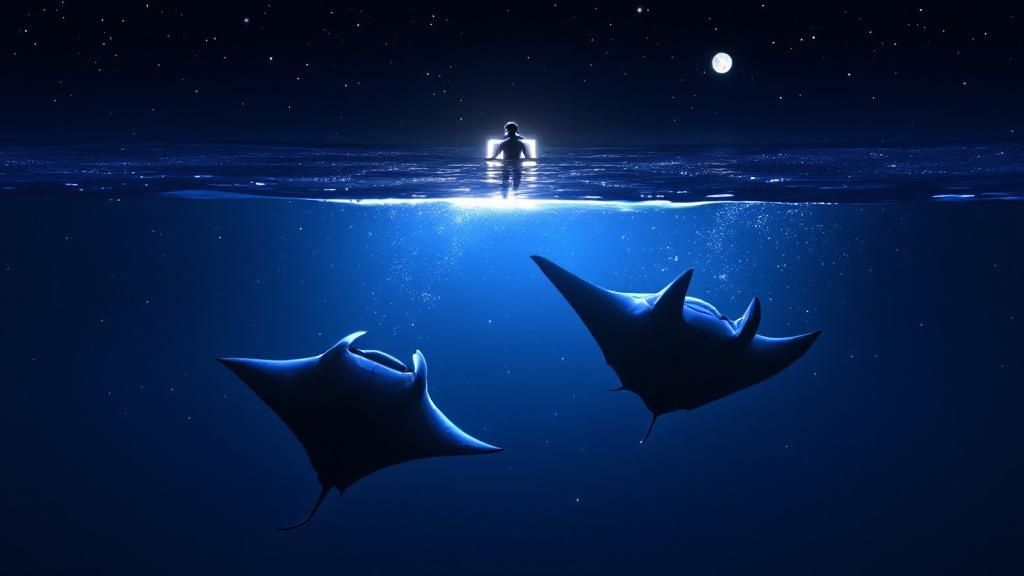
Picture this: you're floating weightlessly in the calm, dark Pacific off the Kona coast. Just inches below you, gentle giants with wingspans stretching over 12 feet glide and dance in the glow of underwater lights. It’s not a scene from a nature documentary—it's the magic of the manta ray night snorkel, an otherworldly adventure that has to be seen to be believed.
Your Unforgettable Kona Manta Ray Adventure
This is one of those bucket-list experiences that people talk about for years. To make sure you have the absolute best time, this guide will walk you through everything you need to know. We’ll cover why this spectacle even happens, what you can expect on the night, and how to pick the right tour for an adventure you’ll never forget.
When you head out with a top-rated crew like Kona Snorkel Trips—the most reviewed and top-rated snorkel company in all of Hawaii—you know you're in for a safe, well-organized, and truly memorable night. Get ready for an experience that will stick with you for a lifetime.
What Makes This Experience So Unique?
The manta ray night snorkel in Kona is consistently ranked as one of the top wildlife encounters on the entire planet, and for good reason. It’s not like daytime snorkeling where you might get a lucky, fleeting glimpse of something cool. This is a guaranteed front-row seat to a spectacular underwater ballet.
Here’s what really sets it apart:
- A Reliable Spectacle: Tour operators have figured out the secret sauce. Powerful, submerged lights are placed in the water, which act like a massive magnet for plankton—the manta rays’ favorite food. This creates a nightly, all-you-can-eat buffet that reliably draws the rays to the same spots.
- Gentle Giants Up Close: Don't let their size fool you; manta rays are completely harmless. They’re filter-feeders without teeth or stingers. You'll get to watch them perform graceful barrel rolls and somersaults to scoop up the plankton, often coming within inches of your mask. It's a breathtaking and intimate encounter.
- An Immersive Sensory Experience: Floating in the vast, dark ocean, with the only light coming from the glowing "campfire" below, creates a serene and almost surreal atmosphere. All your focus is on the majestic creatures dancing in the light.
This incredible combination of predictable wildlife, safe interaction, and a truly magical setting is why thousands of visitors consider the manta ray snorkel an absolute must-do.
You can learn even more about what makes this trip so special by checking out the manta ray night snorkel on our blog. We’re passionate about making this once-in-a-lifetime journey accessible and amazing for everyone.
What to Expect on Your Manta Ray Snorkel
So, what’s it really like to come face-to-face with these gentle giants? The whole experience is a bit like gathering around an underwater campfire, only instead of telling stories, you’re watching the ocean’s most graceful acrobats put on a show just for you.
Your manta ray night snorkel in Kona kicks off just before sunset. You'll head out on the tour boat, cruising over the calm Pacific as the sky explodes in color—a spectacle all on its own.
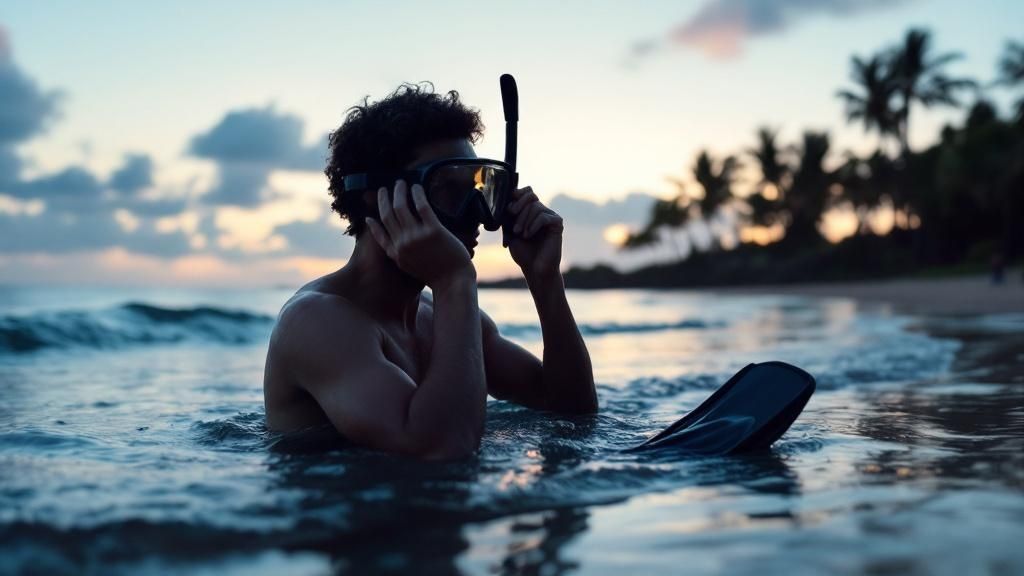
Once the boat is anchored at a specially chosen spot known for consistent manta sightings, the real magic starts. The crew lowers powerful, eco-friendly lights into the dark water. These lights are like a giant magnet for swarms of microscopic plankton, which just so happens to be the manta rays' absolute favorite meal.
The Underwater Buffet Begins
This is where you get in on the action. Your guides will help you slip into the water, already kitted out in a snug wetsuit and snorkel gear. You won't be swimming around on your own. Instead, you'll hold onto a custom-made, floating light board. This brilliant setup is key to the whole experience:
- It keeps you stable: You just float effortlessly, so you don't need to be an olympic swimmer to feel comfortable.
- It brings the action to you: The lights on the board concentrate all that tasty plankton right beneath you, creating the perfect "underwater buffet."
From this incredible front-row seat, all you have to do is float and watch. The whole thing is designed for the best possible view with the least amount of effort, letting you soak in every moment of the main event unfolding inches from your face.
Your Front-Row Seat to Nature's Ballet
As the plankton clouds gather, the mantas arrive. And they are not shy. These gentle giants, with wingspans that can stretch over 12 feet, glide, swoop, and perform mesmerizing barrel rolls to scoop up the plankton. It’s a silent, breathtaking ballet. All you'll hear is the gentle sound of the water as these majestic creatures dance in the beams of light.
The entire experience is choreographed by nature, with the tour crew simply setting the stage. You are a passive observer, which is the most respectful and safest way to witness these wild animals in their natural habitat.
From the professional pre-trip briefing to the moment you see the mantas up close, it's a complete sensory experience. A top-notch tour operator like Kona Snorkel Trips makes sure every single detail is handled, so you can just feel safe, prepared, and totally stoked for what's about to happen. Ready to see it for yourself? You can learn more about their tour here.
Why Kona Is the Best Place in the World to See Manta Rays
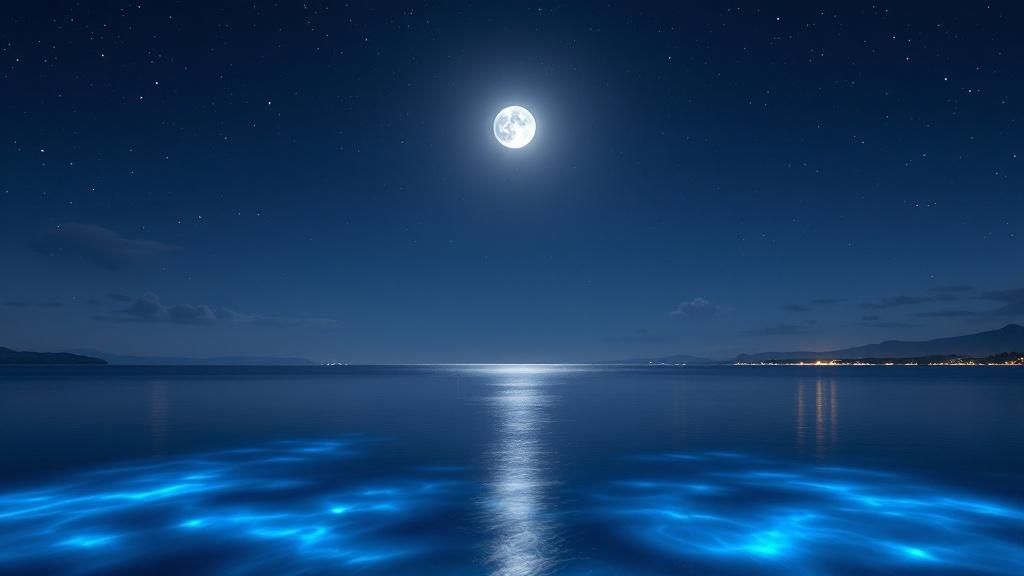
When you hear people talk about bucket-list wildlife encounters, some places are good, and a few are truly legendary. The manta ray night snorkel in Kona is, without a doubt, in the legendary category. It's hands-down the best place on the entire planet to have this experience.
So what's the secret? Why this specific spot on the Big Island? It all boils down to a perfect mix of geography and biology. The Kona coast is blessed with naturally calm, protected bays that act as a shield from the big ocean swells. At the same time, this unique layout creates a consistent upwelling of nutrient-rich water, which is a dinner bell for a massive population of plankton—the manta rays' favorite meal.
Over time, the local manta population has figured this out. They've learned that when the tour boats show up and switch on their bright lights, it's time for an all-you-can-eat plankton buffet. This learned behavior is the magic behind Kona's unbelievably high success rate for manta sightings. While Kona is the undisputed king for mantas, those looking for different kinds of adventures should check out these other incredible journeys around the world.
Kona's Premier Manta Viewing Locations
Two main locations have become the world-famous hotspots for the manta ray night snorkel. This incredible experience is so popular that it draws an estimated 80,000 people every single year to Kailua-Kona. Each spot offers a slightly different flavor of magic.
To help you decide which spot is right for your trip, here’s a quick breakdown of the two main manta ray viewing sites.
Kona Manta Ray Viewing Site Comparison
| Feature | Manta Village (Keauhou Bay) | Garden Eel Cove (Manta Heaven) |
|---|---|---|
| Location | South of Kailua-Kona | North of Kailua-Kona Airport |
| Depth | 25-35 feet | 35-45 feet |
| Conditions | Generally calmer, more protected | Can be more exposed, potential for current |
| Best For | Beginners, families, first-time snorkelers | More experienced snorkelers, divers |
| Manta Sightings | Highly reliable, often 3-5 mantas | Also reliable, can attract larger groups |
| Vibe | The original, classic manta site | Often feels more "wild" and open |
Ultimately, you can't go wrong with either location. Your choice often comes down to your comfort level in the water and what kind of experience you're looking for.
Why It's More Than Just a Tour
The amazing thing about these sites is their reliability. It's almost never a question of if you will see mantas, but how many you will see. This consistency is what elevates a simple snorkeling trip into a guaranteed, world-class wildlife event.
This whole operation is supported by a community of dedicated local tour operators who are serious about sustainability. By following "Manta Ray Green" practices, they make sure these encounters are safe and respectful for both the animals and the visitors. This commitment ensures the manta ray night snorkel in Kona will remain a magical adventure for generations to come.
Meet the Famous Manta Rays of Kona
When you slip into the water for a manta ray night snorkel in Kona, you’re not just watching wildlife—you’re meeting a local family. These aren't just random animals passing through. The local guides and researchers here know these gentle giants as individuals, each with its own name and personality.
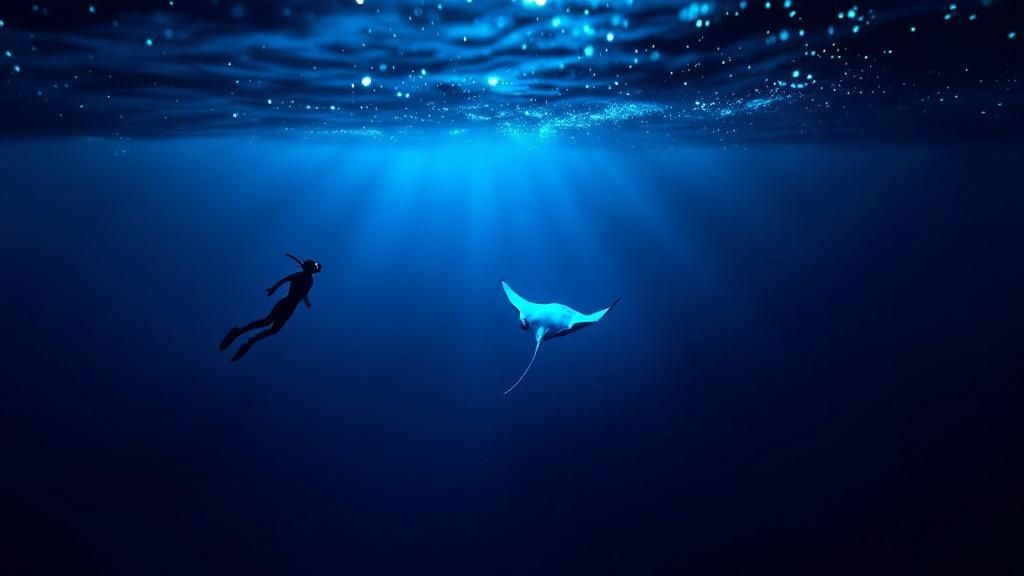
This incredible bond is possible because, much like a human fingerprint, every manta ray has a completely unique pattern of spots on its belly. These markings allow scientists and the dedicated tour operators here to identify, track, and get to know them. It's led to the creation of the "Kona Manta Ray Ohana" (family), a lovingly kept database of our resident rays.
Think of their belly spots as a cosmic nametag. A ray named "Big Bertha" might be known for her enormous size and calm demeanor, while another named "Lefty" might be recognizable by a healed injury on its left cephalic fin.
Knowing who you're swimming with transforms the entire experience. It’s no longer just a tour; it's a personal introduction. Your guide might point out a specific manta, sharing stories of its history, behaviors, and funny quirks.
Graceful Giants and Their Underwater Ballet
The way these mantas feed is something you have to see to believe. As plankton are drawn to the lights, the mantas begin an elegant, looping dance to scoop up their meal. The most jaw-dropping move is the barrel roll, where a manta executes a perfect somersault right in front of you, its mouth wide open to filter as much food as possible.
Witnessing this just inches from your face is what it's all about. It's a silent, breathtaking spectacle that shows off just how incredibly agile and intelligent they are.
The Kona manta population has been studied for years, with researchers identifying more than 120 individual manta rays along this coast annually. What's really interesting is that the top 20 most frequently seen mantas account for nearly 60% of all sightings. This shows there’s a core group of "regulars" who really love showing up for dinner. You can read more about these incredible manta ray findings and the research that makes this tour so special.
Your Snorkel Contributes to Conservation
Every tour does more than just create a lifelong memory; it actively supports real conservation work. The photos and videos that guides and even guests take contribute valuable data to ongoing research. By tracking which mantas appear, how often, and what condition they're in, we can better understand and protect this amazing population for generations to come.
How to Prepare for Your Snorkel Adventure
A little preparation goes a long way toward making your manta ray night snorkel in Kona a totally stress-free and unforgettable experience. When you know what to expect before you even hit the docks, you can just sit back, relax, and soak in the magic of the evening.
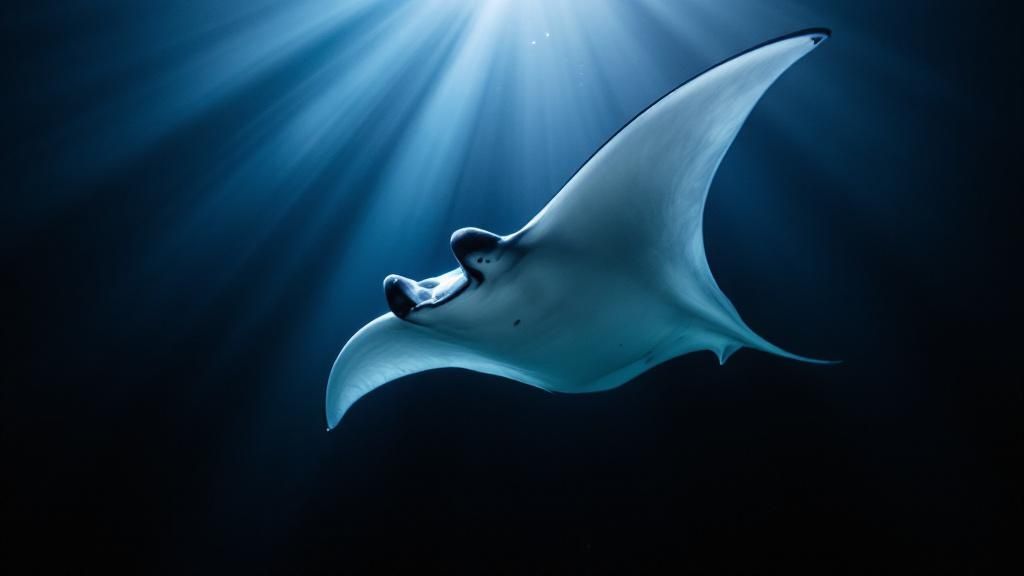
The best trick is to arrive ready to jump in. Just wear your swimsuit under your clothes for a super quick change. All you'll really need is a towel and some dry clothes for after the swim—that boat ride back to the harbor can feel pretty brisk when you're wet!
What to Bring and What to Leave Behind
Think simple. Your tour operator is going to have all the high-quality snorkel gear, wetsuits, and flotation devices you need. That means you can leave all your own bulky equipment at home.
Here's a quick and easy checklist:
- Must-Haves: A towel, a warm change of clothes, and any personal motion sickness medicine if you know you're prone to seasickness.
- Leave It: Valuables, big bags, and your personal snorkel gear. Keeping it minimal makes the whole trip smoother and more enjoyable.
While you're packing for your trip in general, it's always a good idea to have an essential first aid kit on hand in your car or hotel for any little scrapes or bumps you might get on your travels.
Common Concerns and Safety Guidelines
A lot of first-timers get hung up on their swimming skills, but you can put that worry to rest. You really don't need to be an Olympic swimmer for this adventure. Everyone holds onto a big, floating light board the entire time, which gives you all the stability and buoyancy you need. Plus, the wetsuit they give you adds extra float, so you can just lie back and enjoy the show below.
The most important rule out on the water is also the simplest: do not touch the manta rays. These gentle giants have a delicate, slimy coating on their skin that acts as a shield against infection. Touching them can rub it off, leaving them vulnerable. Just look, don't touch, and everyone—you and the mantas—stays safe.
Your professional guides will be right there in the water with you, making sure everyone follows the rules and answering any questions you have. They're your safety net, so you can focus completely on the incredible underwater ballet happening just inches away. Arriving confident and informed is the first step toward an experience you'll never forget.
Choosing the Best Manta Ray Night Snorkel Tour
With a bunch of different tour boats out there, picking the right manta ray night snorkel in Kona can feel like a big decision. And honestly? It is. This choice is what separates a good trip from a truly mind-blowing, once-in-a-lifetime experience. Who you go with directly shapes your safety, your comfort, and how incredible your encounter with the mantas will be.
Going with a top-notch, reputable operator like Kona Snorkel Trips isn't just a suggestion—it's essential. You want a team with a flawless safety record and guides who really know their stuff. A great guide doesn't just point and say, "There's a manta." They tell you the stories behind these animals, explain their behaviors, and make sure everyone in the water feels completely safe and looked after. That's how an adventure becomes both a thrill and a lesson.
Key Factors for a Great Tour
Beyond the absolute must-haves like safety, a few other things make a huge difference. When you're doing your research, zero in on operators that keep their group sizes small. Fewer people in the water means you get a much more personal experience. You won't be bumping elbows around the light board, and you’ll have a front-row seat for the whole underwater ballet.
Also, look for companies that are proud to follow "Manta Ray Green" conservation standards. This isn't just some sticker; it shows they genuinely respect the mantas and their home, making sure these magical nights can happen for years to come. It’s about more than just a tour; it’s about supporting an ethical operation that puts the gentle giants first. For a deep dive into what really sets the best operators apart, you can read our guide on choosing the best manta ray night snorkel in Kona.
An operator's dedication to the guest experience is often reflected in their reviews. As the highest-rated and most-reviewed snorkel company in Hawaii, Kona Snorkel Trips has built a reputation on providing an unparalleled and safe adventure.
Comparing Tour Options and Times
You’ll also notice different tour times, like leaving at sunset versus going out later in the evening. The sunset trips are amazing because you get a classic Hawaiian sunset on your way out to the site. The later trips, sometimes called "moonlight" swims, often feel a bit quieter and more serene, just you and the mantas under the stars.
This incredible adventure typically costs around $199 per adult. The price reflects its status as a world-famous marine attraction that brings in about 80,000 visitors every year. While these tours are a big deal for the local economy, the best companies never forget who the real star of the show is: the manta ray. Ultimately, picking a respected, safety-first operator is your guarantee for an unforgettable night.
Common Questions About the Kona Manta Ray Snorkel
Even after getting the lowdown on this incredible adventure, you might still have a few things you're wondering about. I get it. To wrap things up, let's go through some of the most common questions we hear about the manta ray night snorkel in Kona. The goal is to make sure you feel totally confident and excited when you book your tour.
Is the Manta Ray Night Snorkel Safe?
Absolutely. There's a reason we call manta rays "gentle giants"—it's not just a cute nickname. They are filter feeders, which means they have no teeth, no stingers, and no barbs. They are completely harmless to people.
On top of that, any reputable tour operator like Kona Snorkel Trips puts safety above everything else. We provide all the right gear, from flotation devices to wetsuits, and our experienced guides are right there in the water with you the entire time, keeping a watchful eye.
What if I Am Not a Strong Swimmer?
You don't need to be Michael Phelps to do this! In fact, you barely need to swim at all. Everyone on the tour holds onto a large, custom-made flotation board that has powerful lights built into it.
This board gives you all the stability you need, keeping you comfortably at the surface. Your wetsuit also provides extra buoyancy. You can just relax, float, and watch the manta ballet unfold right below you.
The entire experience is designed to be accessible. It’s all about passive observation—letting the mantas come to you on their own terms while you just hang out and enjoy the show.
When Is the Best Time of Year to See Manta Rays?
This is one of the best parts: it’s a year-round spectacle with a ridiculously high success rate. The resident manta ray population lives right here along the Kona coast all year long, so there's no real "off-season."
Sightings are remarkably consistent whether you come in July or January. Your tour operator will, of course, keep a close eye on the weather to make sure the ocean is calm, giving you the best and smoothest experience possible.
Want to dive a little deeper? Our full guide to manta ray night snorkeling has even more details.
Will I Get Cold During the Snorkel?
The ocean here in Kona is pretty warm, but it can definitely feel a bit brisk after the sun goes down. To make sure you’re comfortable, we provide high-quality wetsuits.
These do a great job of insulating your body and keeping you warm. This way, you can forget about the temperature and just fully immerse yourself in the amazing spectacle without feeling a chill.
Ready for an adventure you'll be talking about for years? Kona Snorkel Trips is Hawaii's highest-rated and most-reviewed snorkel company, and we're dedicated to giving you a safe, unforgettable, and truly magical manta ray night snorkel tour in Kona.
